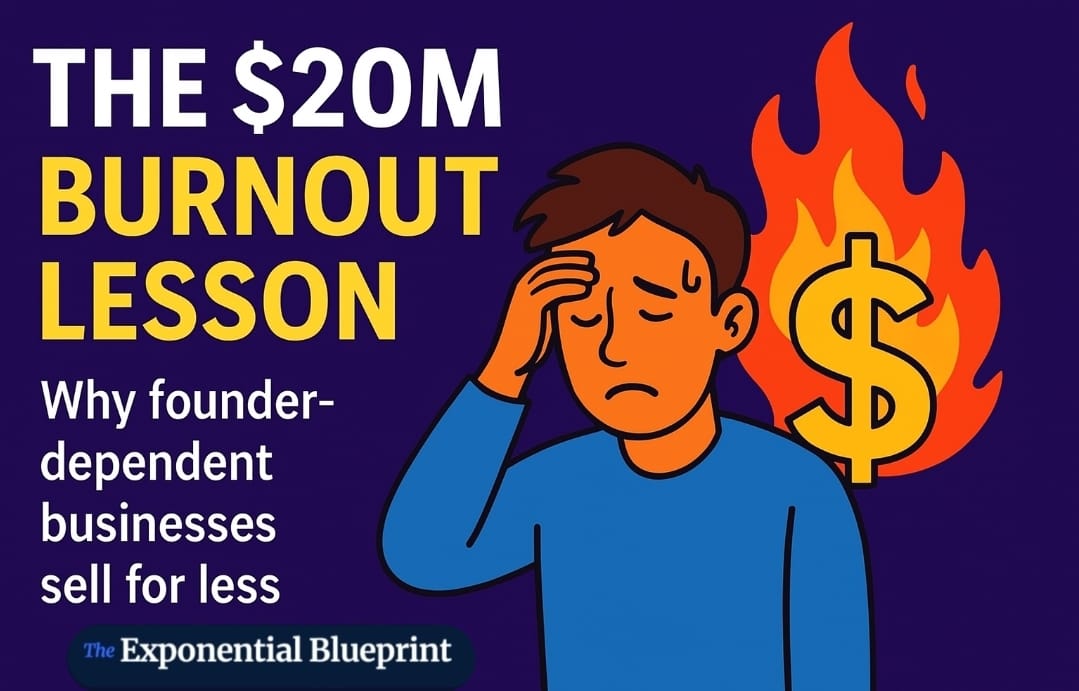- The Exponential Blueprint
- Posts
- The $20M Burnout Lesson
The $20M Burnout Lesson
Why founder-dependent businesses sell for less
Brought to you By : The High Valuation Code, inspired by Fail. Pivot. Scale.

How the High Valuation Code Delivers 10× Funding
Traditional Business Growth | IP-Rich Business (High Valuation Code Framework) |
|---|---|
Collateral = tangible assets (property, stock, machinery) | Collateral = patents, trademarks, data, algorithms, and know-how |
Limited access to finance | Access to IP-backed lending and royalty financing instruments |
Valuation based only on EBITDA | Valuation includes defensible innovation, royalty potential, and transferable value |
Perceived as “operationally strong” | Seen as strategically investable and globally scalable |
Founder-dependent structure | Board-level governance → investor confidence |
No IP filings abroad | International IP portfolio = cross-border capital eligibility |
Focus on short-term revenue | Focus on long-term valuation creation |
The Result
According to the European Patent Office (EPO) and EUIPO, startups holding patents and trademarks are 10× more likely to secure funding.
When those same assets are monetized and governed strategically, exits often reach 2–3× higher multiples than traditional peers.
The High Valuation Code provides the structured path to reach that level — by combining IP Monetization, Leadership & Governance, and Global Expansion into one integrated framework.
🎓 Enrolment is limited to 25 businesses per month to ensure hands-on implementation and direct access to financial leadership strategies.


A Note of Thanks
To the 22,000+ founders, investors, and executives who open this newsletter each week: thank you.
You prove, time and again, that ambition is alive — but more importantly, that you’re committed to building transferable value, not just chasing revenue.
The Founder’s Blind Spot
Most founders build businesses around their own vision, energy, and drive.
That works — until it doesn’t.
Because here’s the uncomfortable truth: if your company depends on you to function, investors will discount your valuation.
And worse, if you burn out, the business burns out with you.
Below Discover The High Valuation Code in this 5 minute-video
The Apple Lesson — $3 Trillion From Succession
Let’s rewind to 1997.
Apple was weeks away from bankruptcy. Steve Jobs returned, refocused the company, and built some of the most iconic products in history.
But here’s the real secret: Jobs also built succession depth.
When his health declined, Apple didn’t collapse. Instead, Tim Cook stepped in — a leader already trusted, proven, and aligned. Under his leadership, Apple scaled its global operations and became the world’s first $3 trillion company.
Apple’s success wasn’t just innovation. It was succession.
Stop the Waste, Start the Shift
In business — and in life — failure comes in two forms.
One erodes momentum. The other creates the opportunity to reset, rebuild, and grow stronger.
Your finances follow the same rule. Allowing cash to leak away on overpriced insurance is the first kind of failure — silent and costly. Choosing a smarter, more efficient option is the second — strategic and value-building.
That’s why I’ve partnered with Quotezone — a platform that lets you compare car, van, and home insurance in minutes. No jargon, no hassle — just clarity and savings. Many people recover hundreds of pounds every year.
As a CFO, I’ve seen how small financial optimizations compound into major valuation gains.
Freeing trapped cash is the first step in strengthening your balance sheet — whether it’s for a household or a business.
So why not start with your insurance?

McDonald’s — A System That Survived Its Founder
Ray Kroc didn’t flip burgers. He built a system.
He turned a small restaurant into McDonald’s by creating repeatable processes, franchising models, and leadership structures that outlasted him.
That system allowed McDonald’s to thrive long after Kroc left the stage. Today, it’s valued at over $200B.
Again, succession wasn’t about stepping away. It was about building a structure investors trusted.
The Small Founder Case — When Burnout Destroys Value
Now let’s make this personal.
A founder I know (let’s call her Sarah) built a thriving B2B services company. She was the rainmaker: the key client contact, the problem solver, the visionary.
Revenue grew fast. But everything depended on Sarah.
After seven years, she was exhausted. Clients called her directly. Staff relied on her decisions. Vacations turned into email marathons.
When she tried to sell the company, investors valued it at just 2x earnings — because without her, there was no business.
This is the hidden cost of ignoring succession.
Why Succession Feels Impossible for Founders
Small founders often tell me:
“I don’t have the budget for a big leadership team.”
“My clients only trust me.”
“I can’t step away without the whole thing collapsing.”
But here’s the shift: succession isn’t about replacing yourself. It’s about building trust in the system.
That can start with:
A strong second-in-command.
Documented processes that live beyond you.
Incentives that retain key staff.
Clear communication to clients that the business isn’t one-person dependent.
The Second Side of the High Valuation Triangle
Succession planning is the second side of the High Valuation Triangle.
The first side (IP monetisation) makes your assets compound.
The second side (succession) ensures your business survives without you.
The third side (going global with precision) multiplies scale.
Ignore one side, and valuation stalls. Align all three, and it feels like magic.
Practical Takeaway for You
Here’s a quick exercise for this week:
List your “single points of failure.”
What tasks, clients, or decisions only you handle?
Choose one to delegate or document.
Create a process, empower a team member, or hire support.
Communicate succession to clients.
Let them see the system, not just the founder.
This one pivot can increase your attractiveness to investors — and give you back your life.
Why This Matters Now
Markets are tightening. Investors are cautious.
And here’s what they’re asking: “What happens if the founder burns out or exits?”
If your answer is weak, your valuation is weak.
If your answer is strong, you unlock multiples most founders never see.
That’s why succession is more than risk management. It’s a valuation driver.
Where The High Valuation Code Comes In
It’s one thing to see the importance of succession. It’s another to build it.
That’s why I created The High Valuation Code — a premium newsletter that decodes how investors silently score your business across all three sides of the triangle.
Inside, you’ll get:
1,040 investor scoring points — including succession readiness.
Case studies of billion-dollar succession strategies adapted for small founders.
Monthly frameworks to build leadership depth without burning cash.
A private founder community where we share and learn together.
And remember: only 25 new founders can join each month. Doors close on the 7th. Miss it, and you wait.
Limited Access: The High Valuation Code
✅ Weekly founder-only premium editions
✅ 1,040 investor scoring points decoded
✅ The Fail · Pivot · Scale toolkit
✅ A private founder community + live Q&As
👉 [Join The High Valuation Code today → insert link]
Enrollment for this month closes on the 10th.
Final Thought
Steve Jobs knew he wouldn’t always be in the room.
Ray Kroc knew systems mattered more than burgers.
And Sarah — like too many small founders — learned the hard way that burnout destroys valuation.
Succession isn’t about stepping aside. It’s about building depth, trust, and systems that survive you.
That’s the second side of the triangle. And it could be the difference between a disappointing exit and a life-changing one.
How did you like today’s Newsletter? |
Until next week.
To your Exponential Success
Matteo Turi
CFO & M&A Strategist
Reply